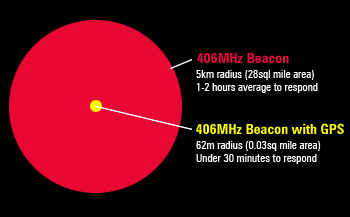April 10, 2012
Now I have a Custom Diver 200/210 dive canister in my possession its time to figure out if the newest ResQLink+ will fit (The floating version is larger) or if its going to be the first version the ResQLink which doesnt float. Im confident one of them is going to fit; its time to figure out which one. Using the specifications from their website I see the standard ResQLink is 3.3cm x 4.8xm x 9.9cm tall. The floating version is a bit thicker and a bit taller; its 4.1cm x 4.8cm x 11.4cm tall.
I start by just taking a ruler and trying to measure the inner dimensions of the dive canister. Its obvious that width and thickness of the unit is not going to be an issue and the crux of this is going to be the height. The standard unit will fit, without a doubt, but the extra height of the ResQLink+ is going to be really tight, I cant really tell positively anything yet. Problem I didnt count on is the canister inside height is hard to measure and take into account how much the threads will actually reduce the heights when the unit is joined together and screwed down. We seem to be talking about just millimeters of difference here could determine whether the PLB will fit or not.
Plan B, make an actual sized 3D version of the ResQLink and just put it inside the damn canister and screw it together! That ought to be a surefire way to see if it fits or not. A quick trip to the garage yields a scrap piece of wood and within a few minutes I have a dimensionally accurate (at least in height) doppelganger. I stick it inside and screw the canister together and it fits! It fits snuggly. I shake it, no noise, cant feel any movement. Wow, there is no room for error what-so-ever. On the positive side Im thinking thats a good thing, there will be no worries of the ResQLink banging around inside the canister at any time, that should be a plus, keeping it nice and snug and safe. On the other hand now, Im looking at the picture of the ResQLink+ that I have printed out and I notice it has two plastic loops at the top and bottom of it. My suspicious mind is starting to wonder just how did they measure their unit to come up with the dimensions? Is the 11.4 cm a true measure of the unit from top of loop to bottom of loop or is that only the measure of the main case of the unit and those loops are not taken into account? If its the latter there is no way it will fit.
I figure Ill try to call the manufacturer and see if I can get some answers. They are in Florida, Im in Colorado, its 7:30am, and they should be at work. I find their technical support phone number and give them a call. A tech support person named Jack answers and I explain what Im trying to figure out. He seems to understand the issue and he says to hold on, that he will go grab one, he has a ruler and he will find out for certain. A few seconds later he declares the 11.4 cm measurement includes the plastic loops on top and bottom. Sweet. Thanks Jack!
So Ive got one canister, Ive made a dummied up version of the ResQLink and gotten it to fit; Ive contacted the company and gotten verification of how they measured it. Next step looks like its time to order a ResQlink+.
To be continued









